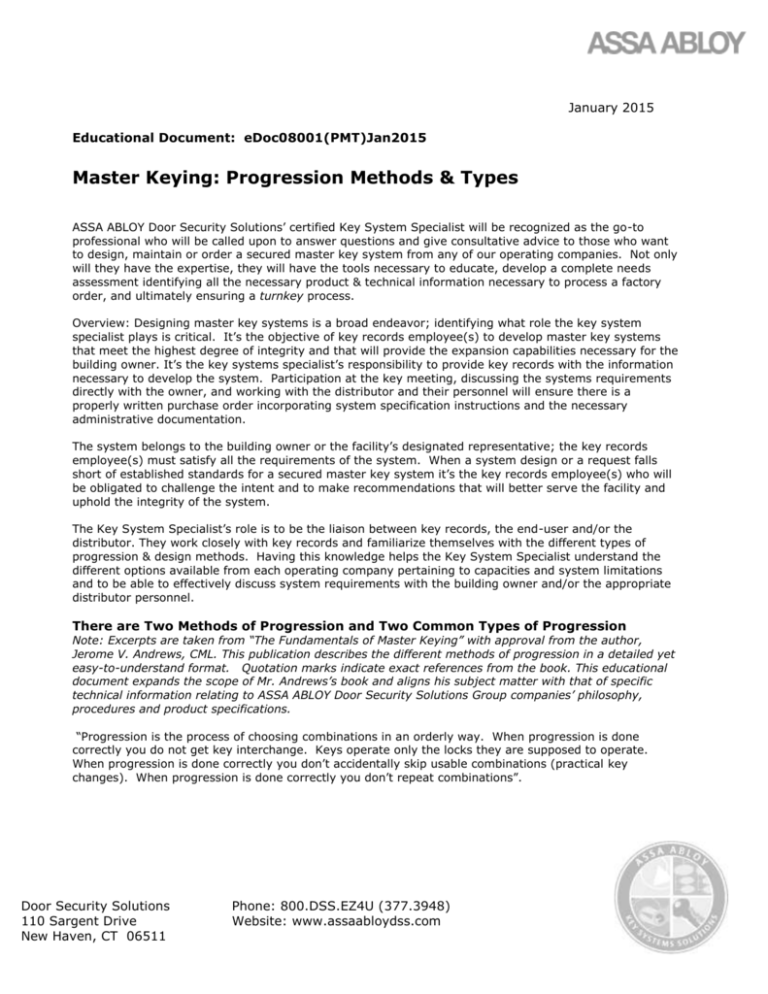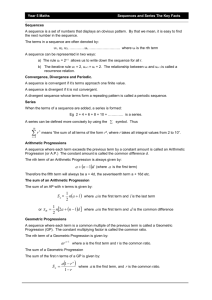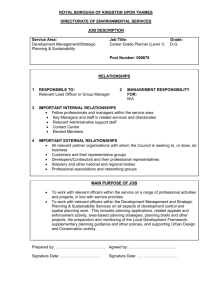
January 2015
Educational Document: eDoc08001(PMT)Jan2015
Master Keying: Progression Methods & Types
ASSA ABLOY Door Security Solutions’ certified Key System Specialist will be recognized as the go-to
professional who will be called upon to answer questions and give consultative advice to those who want
to design, maintain or order a secured master key system from any of our operating companies. Not only
will they have the expertise, they will have the tools necessary to educate, develop a complete needs
assessment identifying all the necessary product & technical information necessary to process a factory
order, and ultimately ensuring a turnkey process.
Overview: Designing master key systems is a broad endeavor; identifying what role the key system
specialist plays is critical. It’s the objective of key records employee(s) to develop master key systems
that meet the highest degree of integrity and that will provide the expansion capabilities necessary for the
building owner. It’s the key systems specialist’s responsibility to provide key records with the information
necessary to develop the system. Participation at the key meeting, discussing the systems requirements
directly with the owner, and working with the distributor and their personnel will ensure there is a
properly written purchase order incorporating system specification instructions and the necessary
administrative documentation.
The system belongs to the building owner or the facility’s designated representative; the key records
employee(s) must satisfy all the requirements of the system. When a system design or a request falls
short of established standards for a secured master key system it’s the key records employee(s) who will
be obligated to challenge the intent and to make recommendations that will better serve the facility and
uphold the integrity of the system.
The Key System Specialist’s role is to be the liaison between key records, the end-user and/or the
distributor. They work closely with key records and familiarize themselves with the different types of
progression & design methods. Having this knowledge helps the Key System Specialist understand the
different options available from each operating company pertaining to capacities and system limitations
and to be able to effectively discuss system requirements with the building owner and/or the appropriate
distributor personnel.
There are Two Methods of Progression and Two Common Types of Progression
Note: Excerpts are taken from “The Fundamentals of Master Keying” with approval from the author,
Jerome V. Andrews, CML. This publication describes the different methods of progression in a detailed yet
easy-to-understand format. Quotation marks indicate exact references from the book. This educational
document expands the scope of Mr. Andrews’s book and aligns his subject matter with that of specific
technical information relating to ASSA ABLOY Door Security Solutions Group companies’ philosophy,
procedures and product specifications.
“Progression is the process of choosing combinations in an orderly way. When progression is done
correctly you do not get key interchange. Keys operate only the locks they are supposed to operate.
When progression is done correctly you don’t accidentally skip usable combinations (practical key
changes). When progression is done correctly you don’t repeat combinations”.
Door Security Solutions
110 Sargent Drive
New Haven, CT 06511
Phone: 800.DSS.EZ4U (377.3948)
Website: www.assaabloydss.com
“There are two methods of progression, the rotating constant method and total position progression.
The two methods have to do with how many chambers have master pins, and will be explained shortly.”
“There are two common types of progression, single step progression and two step progression.”
“The types of progression have to do with the increment and depth system. Tolerance build-up and a
given manufacturer’s increment determine whether we may use single step or two step type progression.”
“Single Step vs. Two Step Type – the Increment Decides”
Explanation of column titles:
# of Pins = Bottom pins are generally numbered 1 through 0 or 0 through 9 depending on
manufactures terminology. Increment is also know as the bitting depth or the overall length of each
pin, example a SARGENT (two step .020 system)bottom pin # 3 is .210” vs. a #4 bottom pin which
is .230” - notice the difference is .020” meaning that the #4 bottom pin is .020” longer than the #3
pin – hence the .020” increment for SARGENT.
Reference each operating company’s technical product data sheets, bulletin and service manuals for
system specifications and product descriptions.
Type of Step
# of
Pins
Increment
Shallowest
Remarks
10
10
.015”
.014”
1-0
0-9
1
0
0 represents 10
10
10
.020”
.019”
1-0
0-9
1
0
0 represents 10
CORBIN RUSSWIN System 70
6
.028”
1-6
1
CORBIN RUSSWIN Access 3
6
.030”
1-6
1
SARGENT Degree
6
.030”
1-6
1
YALE
8
.025”
0-8
Numbered
Two Step
CORBIN RUSSWIN
Pre System 70-Corbin
Pre System 70-Russwin &
Pyramid
SARGENT
YALE
Single Step
0
Existing Systems
only
Definitions:
“Single step progression”
n. “a progression using a one increment difference between bittings of a given position.”
“Two step progression”
n. “a progression using a two increment difference between bittings of a given position.”
Two Step Progression (Two Step Systems)
Consider the two step systems; combinations that differ in only one position by one increment would not
yield sufficient protection against key interchange as recognized by the lock industry, .023” increment
is considered a safe increment. To further explain, lets take a SARGENT (.020” system) bitting of
467530 and 467539, notice the 6th number of 0 is just 1 increment apart (9 vs. 10) – for SARGENT that
would result in only a .020” increment apart from each other – key interchange would result.
Think of the 0 as 10 – do not write a one and zero example; consider a 6 pin bitting as being
467530 if the zero was written as 10 it would show as a 7 pin bitting 4675310.
You’ll find that in all factory designed two step systems only the odd or even cut depths are used
in a given position or chamber. That is, 1, 3, 5, 7, and 9 may be used, or 0, 2, 4, 6, and 8, but
not all ten depths in the same position or chamber. This establishes an effective minimum
increment that is greater than the industry recommended safe increment of .023”. This is also
referred to as parity.
2
One Step Progression (One Step Systems)
CORBIN RUSSWIN System 70, Access 3 and Sargent Degree has 6 depths; numbered 1 (shallowest) to 6
(deepest) proceeding in increments of .028” for Corbin Russwin system 70 and .030” for Access 3 and
Degree for each of the 6 depths. Being .028” or .030” increment apart for each of the 6 increments, the
use of each of the 6 depths are safe, a 1 in the same chamber next to a 2 would be acceptable and would
not cause key interchange.
“Single step progressions use all the theoretical cut depths in a given position, while two step
progressions uses half of them, confining it to evens or odds.”
For master keying CORBIN RUSSWIN, SARGENT, and YALE two step systems, bittings must be two steps
apart in any given position.
Small Format Interchangeable Core (SFIC)
Small format interchangeable core pinning is typically identified by A2, A3, and A4. The A2 is the most
common and its increment is .0125”; it’s a two step system. The increment for A4 is .0210”; it’s a single
step system. The A3 system is not used today.
It’s recommended that you contact key records department personnel whenever you are discussing SFIC
type systems.
Examples of Both Types of Progressions
The following are short examples of single step and two step progressions. Each example consists of a
master and sixteen changes. Both examples use the rotating constant method (we’ll discuss the different
methods later), as the intent of this is to stress the importance of mastering the concept of progressing
combinations (key bittings) in an orderly way. These examples represent the simplest forms of the
process; their intent is to further show the various disciplines necessary to create a secured master key
system’s Key Bitting Array (KBA). They also show the orderly way in which numbers are chosen for each
bitting. Other elements that affect the process are the sequence of progression (SOP), and the different
formats used to write the system.
Example of Single Step Progression
Beneath the last two cuts of the master key bitting, this table shows (in bold print) valid bitting cut
possibilities (or progressives) in each of the two progressive columns. The example is CORBIN RUSSWIN
System 70 (these are theoretical only and do not represent maximum adjacent cut violations). Access 3
and Degree would be similar to this example.
In this example, the first 4 cuts of each change key are the same as the master key bitting numbers 1, 3,
4, 1.
Master Key
Bitting
1
3
4
1
5
3
6
4
1
5
2
6
3
1
4
2
Progression columns contain bittings
one step apart
The progression columns contain alternative cut depths. As you can see, they are different from the
master key cuts in those particular positions. To “progress changes” means to write combinations that
are different from the master key and from one another, and, it means they are written in an orderly way.
3
How many different combinations can you derive using these progression columns? If you said twentyfive, you are right. They are:
1
1
1
1
1
3
3
3
3
3
4
4
4
4
4
1
1
1
1
1
6
6
6
6
6
4
5
6
1
2
1
1
1
1
1
3
3
3
3
3
4
4
4
4
4
1
1
1
1
1
1
1
1
1
1
4
5
6
1
2
1
1
1
1
1
3
3
3
3
3
4
4
4
4
4
1
1
1
1
1
2
2
2
2
2
4
5
6
1
2
1
1
1
1
1
3
3
3
3
3
4
4
4
4
4
1
1
1
1
1
3
3
3
3
3
4
5
6
1
2
1
1
1
1
1
3
3
3
3
3
4
4
4
4
4
1
1
1
1
1
4
4
4
4
4
4
5
6
1
2
The sixth column is changing first. It
changes every combination.
The fifth column is changing second.
It changes every five combinations.
Each of the five possibilities in the 5th column can be combined with each of the five possibilities in the 6 th
progression column. The possibilities multiply 5 x 5 = 25, etc.
4
Example of Two Step Progression
Corbin Russwin pre-system 70, Corbin Russwin Pyramid, Sargent .020” system, Yale .019” and Yale
KeyMark would be similar to this example of a two step progression.
In this example, the first 4 cuts of each change key are the same as the master key bitting numbers 1, 3,
5, 1.
Master Key
Bitting
1
3
5
1
2
7
4
1
6
3
8
5
0
9
Progression columns contain bittings two
steps apart
There are four progression possibilities in each of the two columns. Each of the four possibilities in the 5 th
position (4, 6, 8, 0) can be combined with each of the four in the 6 th position (1, 3, 5, 9). This will yield
sixteen combinations, calculated by multiplication, 4 x 4 = 16 etc.
1
1
1
1
3
3
3
3
5
5
5
5
1
1
1
1
4
4
4
4
1
3
5
9
1
1
1
1
3
3
3
3
5
5
5
5
1
1
1
1
6
6
6
6
1
3
5
9
1
1
1
1
3
3
3
3
5
5
5
5
1
1
1
1
8
8
8
8
1
3
5
9
1
1
1
1
3
3
3
3
5
5
5
5
1
1
1
1
0
0
0
0
1
3
5
9
The cuts in the first 4 positions are the
same.
Start with the first two progression possibilities immediately
beneath the master key, 4, 1. The sixth column changes
first. It changes every combination.
After combining all four progressives in the 6th column with
the #4 in the 5th column, change to the next possibility in
the 5th column, which would be 6, and combine it with the
four possibilities from the 6th column.
Continue in this way with the #8 and #0 cuts in the column
until all sixteen possibilities are listed.
This is the responsibility of the key records
employee(s), not you! Your responsibility is to
provide the system specifications. The key records
employee(s) will design the system in an orderly
and highly secure way!
“Progression is the most fundamental and important technique. It is the least
creative and most repetitious part of master keying, but you absolutely have to get it
right! This is very important!”
5
“The Difference between the Rotating Constant Method and Total Position
Progression”
“The progressions we just reviewed were written according to an industry accepted method that was first
used in the 1800’s by YALE, now called the rotating constant method. You may see books or articles that
refer to it as “hold and vary”.”
“Of the two methods, rotating constant method is older. It is also better from the standpoint of
cylinder integrity, as there are fewer master pins resulting in a more pick resistant cylinder and less
vulnerability to key manipulation or key interchange.”
“Rotating Constant Method”
“Master pins in certain chambers”
“Change key and master key bittings are the same in certain positions or chambers.”
“Total Position Progression”
“A master pin in every chamber”
“Change key and master key bittings are different in every position or chamber.”
Definitions:
“Rotating constant method”
n. “a method used to progress key bittings in a master key system, wherein at least one cut in
each key is identical to the corresponding cut in the top master key. The identical cut(s) is
moved to different location in a logical sequence until each possible planned position has been
used.”
“Total position progression”
n. “a process used to obtain key bittings in a master key system wherein bittings of change keys
differ from those of the top master key in all bitting positions.”
It has been recognized and suggested that the rotating constant method has severe limits beyond two
levels of keying. This is not necessarily true. In a single keyway it does have some merit, however, with
the use of multiplex keyway families and a master key system that has been designed for security rather
than convenience the rotating constant method is very acceptable and legitimate. There are also other
secured methods available to key records. When a system specification and/or size warrants a larger
more complex structure the utilization of keyway families and a partial progression method can be used.
This is why it’s very important to work closely with key records and to give them the specific system
specifications and future expansion needs - key records can tailor the system to meet any system’s needs
and underwrite its integrity!
ASSA ABLOY Door Security Solutions
Key System Specialist
Advocate
ASSA ABLOY is recognized as being a security provider for both logical and physical security, and we want
to build on that already established reputation. Realizing that master keying is a very essential part of
any facility’s physical security plan; we want to be the go-to company for any facility, or building owner
who is considering a new master key system or thinking of re-keying an existing one.
ASSA ABLOY Door Security Solutions endorses the development of secured factory master key systems
and supports key records’ processes and proven procedures in the development of these types of systems.
As an ASSA ABLOY Door Security certified Key System Specialist, here are a few recommendations you
should consider and embrace when discussing master key systems:
1. Always recommend establishing a new factory secured master keyed system.
2. Be the liaison between key records, the end-user and/or distributor.
3. Work closely with key records to ensure proper system structure.
6
4. Recommend a patented locking system and where possible security or high security cylinder
mechanisms.
5. Settle for nothing less than for all cylinders to be certified to ANSI/BHMA A156.5 – Grade 1.
6. Settle for nothing less than the cylinder and lock to be from the same manufacturer. Our number
one priority is to furnish the CORBIN RUSSWIN, SARGENT, and YALE patented locking cylinders
together with the lock where ever possible! We want to avoid separating them!
7. Work closely with the building owner or facility personnel to assure that all security objectives
have been identified and met and that the proper locking segment has been selected.
8. Be the advocate of key control & key management initiatives and promote Key Wizard ® software.
Educational Document: eDoc08001(PMT)Jan2015
© Copyright ASSA ABLOY SALES AND MARKETING GROUP INC. 2015. All rights reserved.
7




